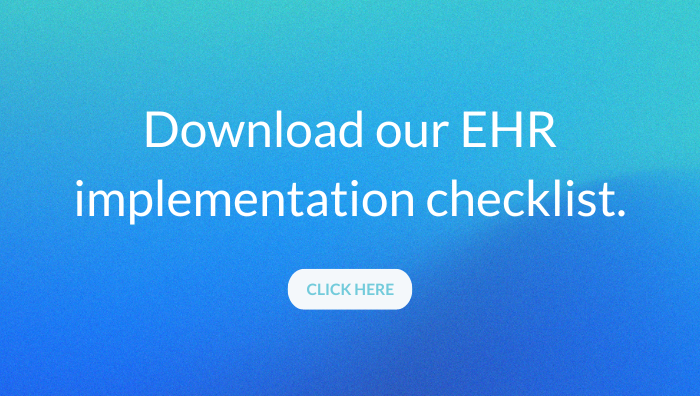Healthcare organizations are on a journey towards digital transformation, and one important aspect they need to consider is the implementation of Electronic Health Records (EHR).
EHRs provide a centralized database where patient health information can be stored, accessed, and managed. It’s crucial to successfully implement this technology because it helps hospitals streamline operations, enhance patient experience, and reduce medical errors.
As an Oracle Health EHR consultancy, we’re here to guide you through the process. So let’s dive in and explore key strategies for a smooth implementation, including understanding timelines, resource allocation, support, and effective project management.
Don’t want to read the whole post? Click here for our EHR implementation checklist.
Preparing for Oracle Health EHR implementation: timeline and staff requirements
Successful Oracle Health Millennium EHR implementation requires three things: realistic expectations; additional expert support; and meticulous planning.
Starting with realistic expectations, it’s important you know in advance how long it can take to implement a new EHR. Typically, a complete EHR implementation can take between one and four years, depending on the size of the organization and the complexity of the project. And by complexity, we mean the number of facilities and workflows to be considered. This is because the more facilities, the more people that need to be involved in the design.
Also important are your expectations of how the EHR technology will work and support your organization. The more on board your team can be in understanding and accepting the technology and how it works, the better.
Prior to starting at EHR Enhancify, we saw several cases where clients pushed back a lot on how Oracle Health (then Oracle Health), or Millennium itself worked. This lack of understanding can really derail projects. Oracle Health tries to educate clients on Millennium and Oracle Health projects but in many cases, this is not enough, which is why having the support of a consultant can really make a difference. They can provide adequate training and access to educational resources to help prepare your staff for a successful implementation.
In terms of planning, there should be a large number of experts involved and it is essential that these individuals have a solid understanding of the organization’s clinical and administrative workflows, as well as a working knowledge of the EHR system itself. Ideally, each solution area should be represented by at least two SMEs (Subject Matter Expert) and one or two analysts. And then there’s the IT analysts that must be involved too, along with project management, change agents, super-users, champions and trainers. Client teams can extend between around 20 people to nearly 100.
This may seem daunting but to help, Oracle Health has a formula for clients to work out how many people they should involve. European clients tend to assign less resources to the projects than US implementations – we’re not sure why!
Leveraging Oracle Health support
At EHR Enhancify, we’re proud to work on Oracle Health EHR but that’s not to say we don’t see areas for improvement. One is in the area of client support.
During the implementation project, the Oracle Health EHR implementation team takes care of leading the client and provides support. After go-live, however, the project team moves away and clients can ask for help from Oracle Health’s general support team. Clients can ask questions and report issues but they won’t receive support on client specific customized details.
So, for example, if a client is struggling with a data extract, Oracle Health’s support might help in identifying some of the database tables needed, but they won’t review the code, nor will they analyse why it does not show the data the client expected.
Oracle Health draws a line between solution support and consulting. Consulting support is sold separately from general support, which is why it’s important for the client to have expert analysts in-house or external consultancy support who can understand and maintain the details and customizations of their Millennium system. Clients can’t depend on Oracle Health to do everything for them. To get started with a consultant, get in touch.
Defining success for an EHR Implementation
From a hospital IT manager’s perspective, a successful EHR implementation should result in:
- Improved clinical workflows and efficiencies
- Enhanced patient care quality and safety
- Reduced manual processes and errors, and
- High end-user satisfaction
But these are long term goals.
In our opinion, the most important measure for IT managers of an EHR implementation’s success is whether or not they are able to take charge of the system once the Oracle Health implementation team has handed over.
During the base implementations, Oracle Health leads and IT managers mainly just support the implementations. However, once the Oracle Health consultants leave, the IT manager needs to continue maintaining the system, deal with all stakeholders and address any new needs that are identified. That’s a lot.
If end-users are properly trained, accept the system and have their needs addressed during the implementation, then the post go-live maintenance will be much smoother.
Also, of course, the IT team needs to have the knowledge to maintain the system. This knowledge comes after spending at least one year working with the platform; not after a few days of maintenance training. Again, this is where a consultant can help, tying you over until your team is up to speed to work independently.
Ensuring a smooth transition
Project leads play a critical role in ensuring a smooth EHR implementation. As with any project implementation, it helps to:
- Establish a clear project scope and realistic timeline
- Allocate necessary resources for the implementation team
- Facilitate effective communication among team members and stakeholders, as well as the Oracle Health implementation team
- Ensure staff members receive adequate training and support
- Proactively address challenges and take corrective actions as needed
- Routinely monitor project progress and adjust plans accordingly
Of course, with our vast experience of Oracle Health EHR implementation with clients, we would add the following important points:
- Make sure the staff assigned to the project are very engaged and help them see their responsibility
- Learn as much as possible about Millennium (high level) and about the decisions that are being made during the project
- Continuously and very openly promote the project among end users and stakeholders
- Take Oracle Health’s recommendations very seriously. Taking a view that “we can change it later” or “I’m sure our approach is better” could prove troublesome
- Make end users and staff feel part of the project to get their buy in
Useful programs and templates for a successful EHR implementation
Unfortunately, there aren’t any specific programs or templates that will help you here. There are, however, some tasks clients can do to prepare for a Millennium implementation:
- Get main workflows documented on a high level (or identify people in the organization who can explain the main workflows)
- Document the high level security features in the EMR being replaced
- Extraction of the patient location hierarchy for the EMR being replaced
- Create a list of third party systems with a description of the environments for each system and a contact person for developments and support. It is important to have third party vendors engaged for the new implementation project
- Create a set of paper templates / forms which end users utilize to document results and orders
- Map out high level reporting needs
- Be ready to explain to Oracle Health the main issues with your current EHR and what objectives your organization hopes to achieve with Millennium
- Create a list of certification or legal entities with which there is a need for any kind of integration
- Be ready to describe on a high level how changes to be made to the current EHR are identified and implemented
- Be ready to describe how end user training is managed.
Training and education
Put simply, the more training everyone on the project has, the better. Oracle Health does provide training to clients but like most forms of training, you don’t appreciate its value until you need to put the knowledge to practical use. Bear that in mind before your training ends!
There are two kinds of training: end-user training and solution maintenance training. Both are delivered towards the end of the project. Oracle Health does coach clients during the project but in order to avoid any gaps, it’s better to bring on a consultant who can cover off everything you need, as many times as your stakeholders need it.
The consultant’s role
If this all sounds like too much for your current IT team to handle (don’t worry – it is a lot!), then getting the help of a healthcare IT consultant can be a simple solution. They can provide valuable expertise and support during the EHR implementation process, including:
- Recommending the best EHR system for the organization’s specific needs
- Supporting SMEs, analysts and managers to understand the EHR and why it does what it does
- Making recommendations for design and helping articulate the requirements to Oracle Health in a way that leaves no room for miscommunication
- Problem solving and carrying out implementation tasks quickly and efficiently so that your team can take on other priorities
- Assisting with project management, including planning, coordination, and risk management
- Ensuring greater alignment between the EHR system and the organization’s medical and administrative workflows
- Facilitating knowledge transfer between vendor support teams and hospital staff
In addition to that, here’s an example of how EHR Enhancify could help a client with a very specific implementation issue…
Let’s assume the following scenario: a client has an integration with a third party system that sends charges into Millennium. For Millennium to receive charges (through HL7 messages), an encounter needs to exist in the patient’s chart. Oracle Health has to simplify integrations as implementation projects have a limited timeline and scope. So it would be typical for Oracle Health to suggest the end users to manually create the encounters in Millennium and to be sent into the third party (even if the third party end users don’t intend to use Millennium). The incoming charge would be linked to the encounter created manually created in Millennium.
We could streamline the process by creating the encounter automatically, thereby avoiding the need for the end users to do this manually. Once the system is live, we can support the IT team by splitting the incoming charge message into two message iterations: the first one would be converted into an ADT message to create the encounter. The second iteration would be the actual charge message and would be linked to the recently created encounter. Problem solved!
Are you about the implement Oracle Health EHR at your organization? Get in touch with EHR Enhancify to ensure a smooth process.




